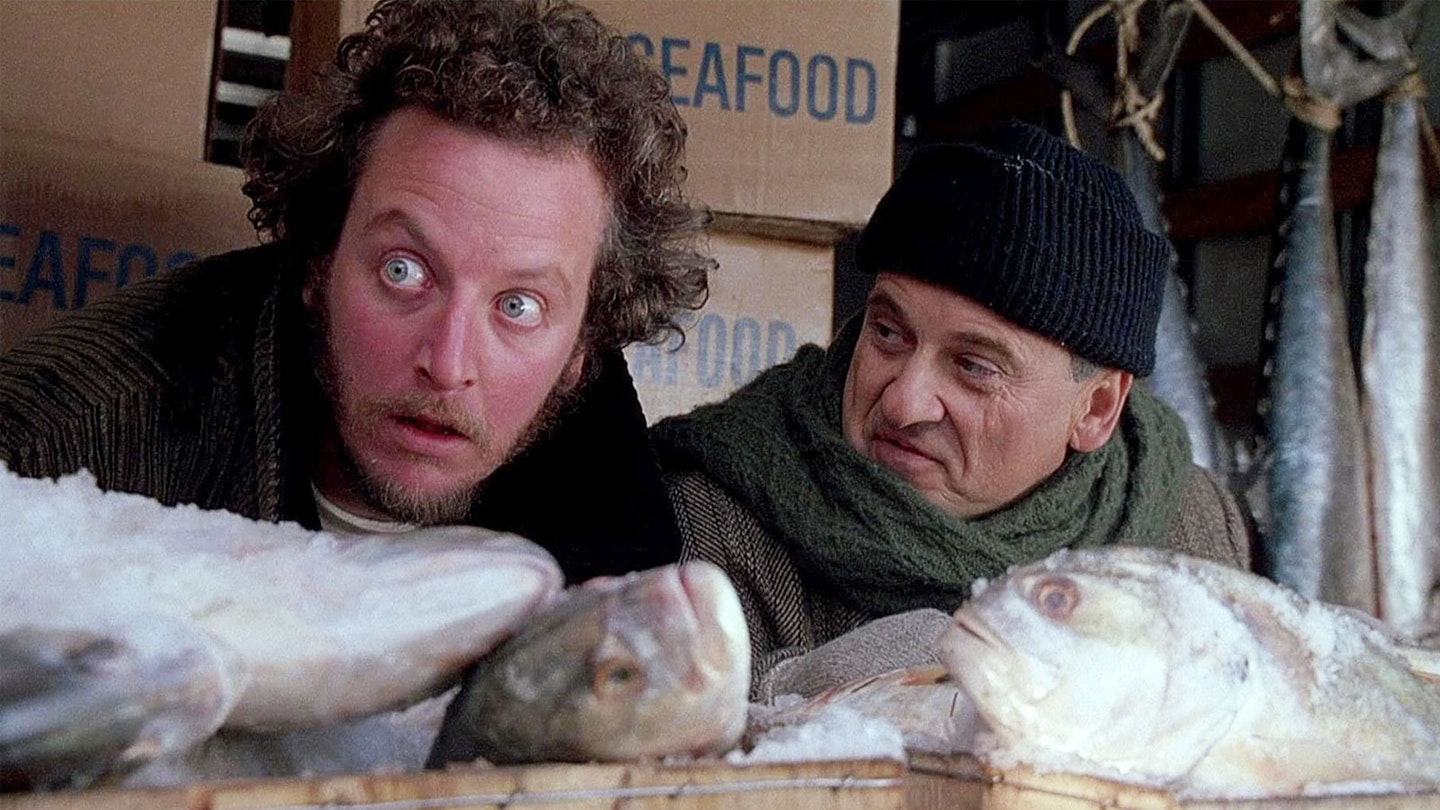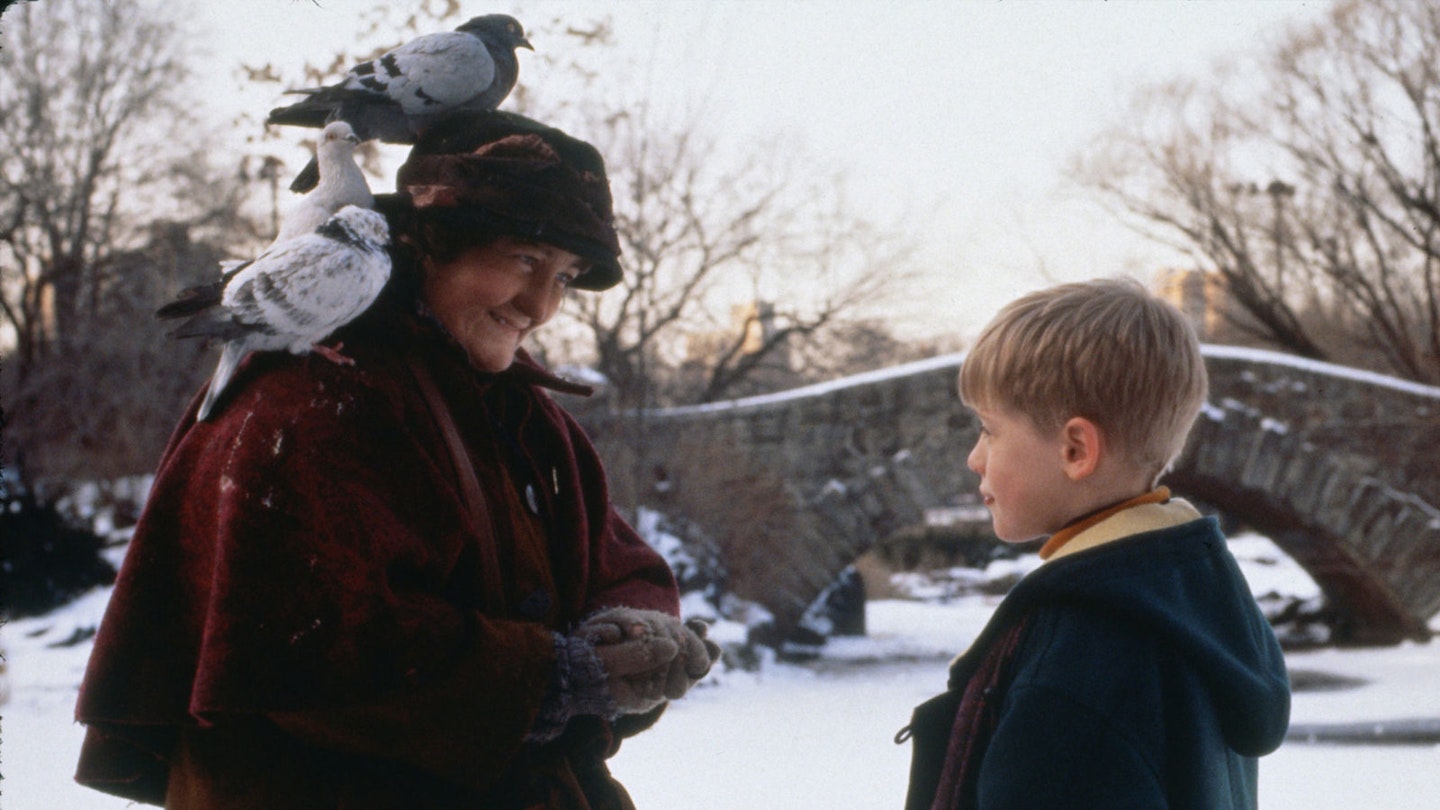“Another Christmas in the trenches!” – Kevin McCallister
Home Alone is, indisputably, one of the greatest Christmas movies of all time. It is a film that practically needs no introduction: directed by a pre-Harry Potter Chris Columbus, written by a post-Breakfast Club John Hughes, starring a post-Uncle Buck, pre-Pizza Underground Macaulay Culkin in an instantly star-making role as the gleefully sadistic Kevin McCallister – a boy left to defend himself from armed burglars after his family accidentally leaves him alone on Christmas. You already know all this, because Home Alone is ingrained in our collective consciousness, encoded into our very souls by virtue of its annual recurrence in our lives, marked into our minds like a hot iron on Joe Pesci’s hand. It’s why we regularly see “Keep The Change, You Filthy Animal” inscribed on Christmas jumpers every December; it’s why we know the the dangers of bare feet against Christmas tree baubles; it’s why we all secretly sometimes like to bounce on the bed when we, too, find ourselves in an empty house. (Come on, admit it.)
But here’s the twist: Home Alone is a classic, sure. But the sequel, Home Alone 2: Lost In New York is better.

It is my deeply-held yet entirely factual belief that Home Alone 2: Lost In New York belongs in the rarefied pantheon of sequels that bettered their predecessors. It is the Godfather: Part II of Christmas movies, the Terminator 2of the Family-Friendly genre, the Trois Couleurs: Rouge of Films Where A Man Takes A Nail Gun Up The Arse. It is better than the original and I will hear no arguments to the contrary.
It is a miracle of a film. What’s miraculous, too, is how quickly it all came together. After the world-conquering success of the original 1990 film (it grossed nearly half a billion dollars against an $18 million budget), a sequel was enthusiastically fast-tracked by the studio, 20th Century Fox. John Hughes finished the script for Home Alone 2 just three months after Home Alone was released; the film arrived in November 1992 in time for the Christmas rush, and became another megahit, with Kevin McCallister’s favoured recording device, the Talkboy — custom-made for the film — quickly becoming the must-have stocking filler of 1992.
This is a film that recognises the greatness of what came before and wisely hews as close to that winning formula as possible.
But contemporary writers did not, at the time, appreciate its genius. Most critics were fairly scathing. Roger Ebert, in his two-star review, scolded that “cartoon violence is only funny in cartoons.” Even Empire was sniffy, its middling three-star review acknowledging: “The fun here, of course, derives from a certain familiarity with the material, as gags are repeated and situations reprised, the assumption being that what you've seen once and laughed at, you'll laugh at again... the law of diminishing returns applies here, as with most sequels.” Many reviews seemed to centre their criticism around a similar sentiment: isn’t this film just a carbon copy of the original?
To which I would enthusiastically respond: Yes! Absolutely! And that’s the point! M’lud, if I may, I would like to cite the legal precedent of “If It Ain’t Broke, You Are Not Obligated To Fix It”. Like Evil Dead II, this is a sequel that effectively also functions as a remake, a film that recognises the greatness of what came before and wisely hews as close to that winning formula as possible. All the booby traps, cheesy goofery and heartwarming schmaltz you remember from the first film are still there, present and correct — just enhanced, supercharged, given a bit more cash (the budget for the sequel was reportedly double the original) and transplanted to the Big Apple.

The film itself even seems to acknowledge the similarities with what came before, openly embracing the resemblance. “The last time we tried to take a trip,” Catherine O’Hara’s iconic Kate McCallister, mother of Kevin, observes in the film, “we had a problem that started just like this.” Multiple sequences in Home Alone 2 are near-identical to the first film, filmed by Columbus almost shot-for-shot, like Gus Van Sant’s Psycho. There is the pre-Christmas hubbub in that giant Illinois mansion, along with an entire family’s inability to set an alarm properly. There is an airport dash in the terminal of Chicago O’Hare International Airport (soundtracked both times by John Williams’ sublime motif, the appropriately-named banger ‘Holiday Flight’). Even the James Cagney-esque film-within-a-film that Kevin watches on VHS in the first film, ‘Angels With Filthy Souls’, gets an imaginatively-titled sequel of its own: ‘Angels With Even Filthier Souls’.
But what’s striking is how Lost In New York repeats the pattern by improving upon it. The first Home Alone was sheer childhood wish fulfilment, catnip for its pre-teen audience who dreamed of running riot in their domiciles, away from the prying eyes of parental supervision; the second film only amplifies this kind of giddy dream-granting, offering small people from suburbs a simple, tangible new goal: to roam around the streets of New York City like a little lord. What if you not only ditched your family, but got to have an amazing city break too?
By setting the final showdown in a house undergoing renovations, the filmmakers give themselves room to be more ambitious, wild, and far more brutal.
It was certainly wish fulfilment for me. I remember, as a boy, watching Kevin McCallister gawking out of the window of a yellow taxi crossing the Queensboro Bridge and wishing I could one day do the same. It was probably the first significant screen depiction of the city that I’d ever seen, and shaped my conception of it to this day – as it likely did for most people of my generation. Suddenly I was aware of this mad, magical place, where an eight-year-old boy could live a life of luxury, with only a dream in his heart and his father’s credit card in his pocket; a place where the skyscrapers stretched to the heavens, the toy shops expanded to over 45,000 square feet of floor space, the fireworks were available for sale to any child who wanted them without need of ID, and pizza was readily available in limousines as standard. Who among us wouldn’t wish to one day order room service from the Plaza Hotel, where a bow-tied waiter serves more flavours of ice cream than your heart could ever hope to imagine? (“Make it three scoops,” says Kevin in that memorable scene, solidifying his hero status to millions of sweet-toothed schoolchildren. “I’m not driving.”)
It’s not just in the ice cream department that stakes are raised, either. Events reach a crescendo, as we know they will, in the film’s final act: the ultimate showdown, the franchise’s raison d'etre, the reason we’re all here in the first place, when Kevin sets his battle plan and the hapless criminals fall victim to his series of booby traps. The final 30 minutes of Home Alone 2 are, without question, the high point of the film series; it may just be the high point of film. By setting the final showdown in a house undergoing renovations, the filmmakers give themselves room to be more ambitious, wild, and far more brutal – there are no qualms about ruining the furnishings when the house is already a wreck. It begins with a small boy lobbing bricks from the fifth floor of a townhouse at Oscar-winning actor Joe Pesci (and hitting Daniel Stern); it only gets funnier, and sillier, and more cartoonishly violent from there.

Home Alone is often talked of as a live-action cartoon, and the parallels are certainly all there — Pesci makes garbled grumbles in lieu of swearing akin to Yosemite Sam, while Columbus even chucks in the odd “boing!” sound effect for good measure. But it has just as much in common with the silent comedy masters of early cinema, slapstick geniuses like Chaplin, Keaton, Lloyd, Arbuckle: comedians whose visual grammar was purely physical, funny in every language. Each stunt tells its own story, each gag has its own mini-narrative.
Take the paint pot gag in Home Alone 2, which repeats a similar stunt from Home Alone (Kevin chucks paint pots tied to string from the top of the a staircase and lamps the bad guys in the face — chef’s kiss). Harry and Marv remember it this time, and pretend to be hit, thinking they’ve outsmarted Kevin; then Kevin chucks a giant metal bar at the pair of them, sending them flying. It’s storytelling through action: the hubris and stupidity of Harry and Marv, outmatched by the resourcefulness of a cheeky little imp using brains over brawn. Later, we can only marvel at the sheer elaborate ingenuity of forcing the robbers to climb down a gasoline-soaked rope, setting the rope on fire, then having their fall trigger a catapult of varnish to fall on them — and then have that varnish be set-up for a tar-and-feather gag? James Joyce wishes he could write a plot like that.
That’s the real secret to Home Alone 2’s success: it is joy-giving, an endless supply of festive good cheer, through its glorious slapstickian schadenfreude and beyond.
Physical comedy is often sneered at as being the lowest common denominator, but it’s incredibly hard to get right. (Credit must go to stunt coordinator Freddie Hice and his stunt team, who do astonishing work in this film, making the pratfalls look seamless — no CGI doubles here.) It’s harder, still, to make it enduringly funny, something that you can watch practically every year of your life (as I have) and still giggle so hard that hot chocolate spurts from your nose (as I have).
That’s the real secret to Home Alone 2’s success: it is joy-giving, an endless supply of festive good cheer, through its glorious slapstickian schadenfreude and beyond. Even away from the violence, there are moments to warm the cockles. In Brenda Fricker’s ‘Pigeon Lady’, we get a surprisingly rounded and empathetic portrayal of homelessness, as Kevin slowly learns not to be afraid of what he doesn’t know. “I wasn’t always like this,” she tells Kevin, humanising an often-ignored underclass. In Tim Curry’s pantomimic hotel concierge, we get some delicious, ever-quotable line-readings (“What's the matter? Store wouldn't take your... stolen credit card?”). That even Donald Trump — who demanded a cameo in exchange for use of his hotel as a location — does not dim the film’s joy with his presence is simply testament to its shimmering brilliance. This is a film with a finely-tuned moral compass. It has a big heart.
With the bad guys defeated, Home Alone 2 concludes with Kevin re-learning the importance of family, happily reunited with his vast extended brood on Christmas day. It is, once again, a near-identical repeat of what came before, hitting all the familiar beats and rhythms of the first Home Alone. But there’s some extraordinary comfort in that familiarity — which is why I, and so many others, keep coming back to it, year after year. It gives us all a snuggly reminder of Christmases past, a little top-up of the festive warm-and-fuzzies we once experienced as children, a portal to a starry-eyed, more innocent past, when you could cry laughing at silly stunts and feel nothing but pure, undiluted happiness. The true meaning of Christmas is watching a small boy fire a nail gun into the face, arse and balls of a burglar, and Home Alone 2: Lost In New York knows it. Looks like another Christmas in the trenches.
